The Westland garden
EXCLUSIVE INTERVIEW

EXCLUSIVE INTERVIEW
Imelda Staunton and Jim Carter share their passion for gardening and their support of Greenfingers Charity, p16
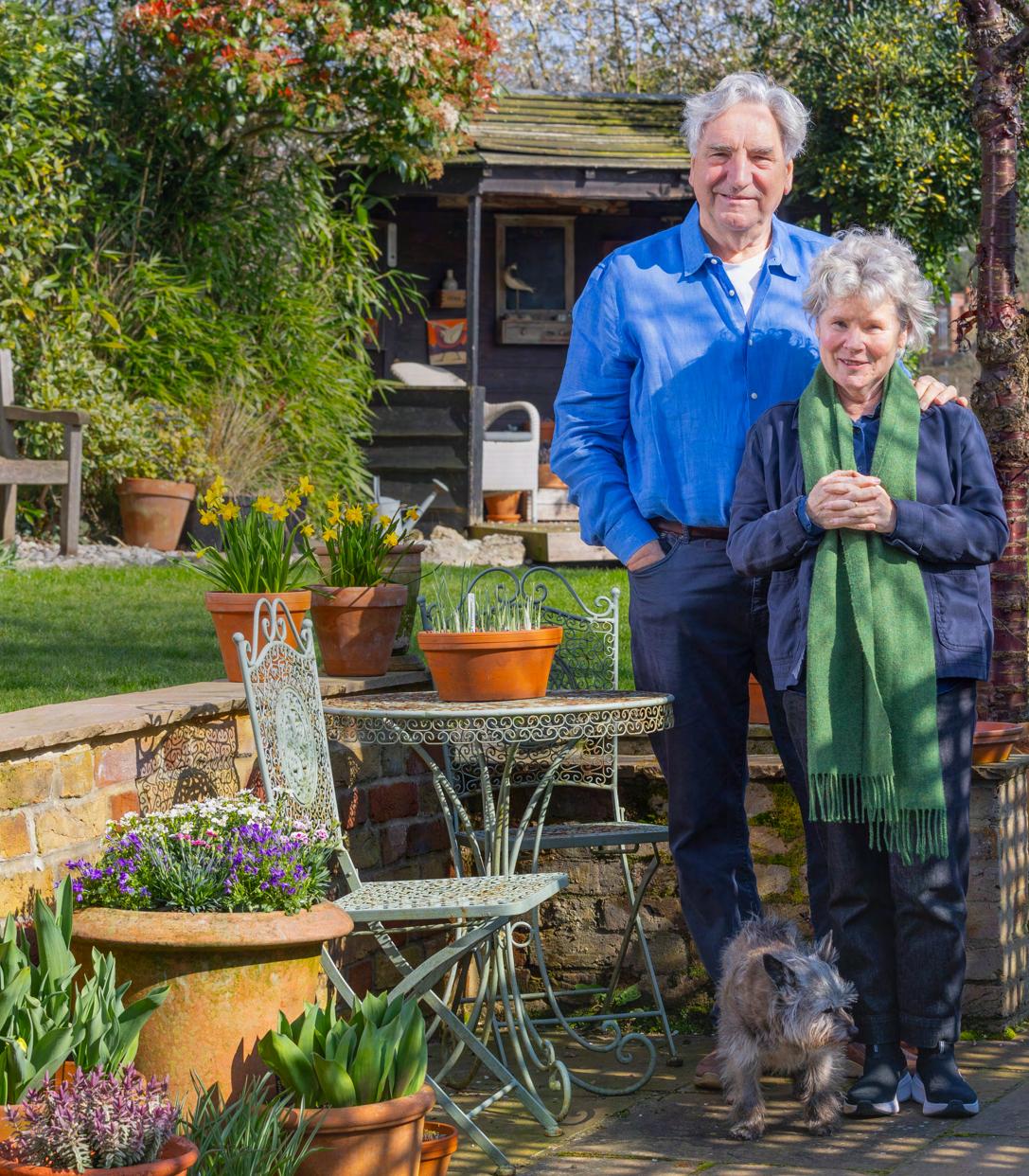

Keep your lawn looking its best this season, p9

All the different types of compost explained, p10

Signs that you need to repot your houseplants, p15
Create a glorious hanging basket
Follow our step-by-step guide to create a beautiful display
If you’re short on time, make a big impact
Michael Perry’s top plants to add to your garden Flowers to sow now
Seed sowing as the weather has warmed up
Grow a bountiful harvest this year with a few simple steps
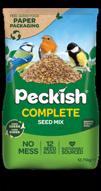
Wildlife
Which birds will be visiting your garden? p24
Could there be a better time in the garden than right now? The cold of winter has (finally) gone; there are flowers and buds at every turn; the grass is growing; and wildlife is getting busier and busier. This is surely peak gardening?
And that’s why we at Westland Horticulture have launched this newspaper. We want it to be your trusted gardening partner, providing a plethora of gardening advice at key times of the year. Gardening and growing can, sometimes, be a little complicated with rules of ‘don’t do this’ or ‘don’t forget that’. But we want to change that and show there are lots of positives about gardening – small steps that can make big impacts, with seed sowing, tending the soil, veggies to grow, or plants to love. In this world of social media and everything being on a screen, we believe a printed, quality newspaper that you can pick up in your local garden centre will be a great source of helpful advice and inspiration to get your garden flourishing. Let us know what you think by getting in touch using the details below – we’d love to hear from you.
Happy gardening and enjoy the season ahead.

Westland Horticulture is home to brands including Boost, New Horizon, Big Tom, Resolva, Peckish, Kent & Stowe, FloPro and Unwins. We’re dedicated to helping the nation create and maintain beautiful, healthy gardens that support wildlife. We have a rich heritage that spans over 30 years, and we pride our brands on being the trusted partners that our customers can rely on, season after season.
Our mission is to equip everyone with the tools and knowledge to help them give it their best in their garden. We believe that anybody can transform their outdoor space into a vibrant and sustainable ecosystem. Our success is rooted in our dedication to customer satisfaction: we want everyone to have a garden that makes them proud, whether that’s a large landscape or a couple of colourful pots.
If gardening time is tight in the weeks ahead, try and get these five things done…
What wildlife will you be sharing your outside space with this spring?

1 L awns: check your mower height when getting on top of your lawn this spring so you don’t cut too low as this could damage the grass. Now is the time to start feeding with a general fertiliser such as Westland SafeLawn to ensure you have a strong and healthy lawn. It’s not too late to overseed your grass, which is a great way to achieve a lusciously, thick lawn.
2 Ready to chop: spring-flowering shrubs, such as flowering currant (Ribes) and Forsythia, that bloomed in early spring should have their flowered growth cut to the nearest strong shoot. Using sharp secateurs, such as Kent & Stowe’s Eversharp, will ensure a clean cut, helping the plant to heal quicker and reduce the risk of infection and diseases.
under cover until all frosts have passed. Feeding is the key to a bumper crop, and make sure you get a bottle of Big Tom Super Tomato Food ready for when plants are established.

5 Welcome first flowers: start to plant seasonal bedding (such as petunias and begonias) outside in borders or containers but be mindful of late frosts. For plants that have been protected indoors over winter – such as succulents and fuchsias – it’s time to move them outdoors.

Blue tit s will be caring for their eggs and by the end of the month, feeding their young. Top up your feeders with Peckish Blue Tit Blend to keep them visiting your garden. This fruit, nut and insect mix is high in energy and packed with vitamins to keep blue tits healthy.
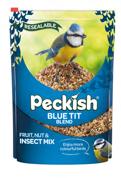

3 Don’t stop weeding: many weeds are now in full growth so keeping on top of them reduces problems later in the season. In wilder corners though, some weeds can be kept to help boost your garden’s biodiversity. Make weeding less backbreaking with a Kent & Stowe Daisy Grubber or if you need a quick fix, use Resolva Xtra Fast Weedkiller.
4 G et veggies going: sow runner and French beans, courgettes and squash indoors for planting out next month. You can also buy these as young plants from garden centres – keep them
Take time to sit back and relish the beauty of late spring. While summer may be more colourful, this is certainly the most exciting and inviting time of the year!


Tree bumblebees are one of the first bees to be seen in spring, especially in towns and cities, and can often be seen flying around empty bird boxes and roof spaces looking for a queen bee. Adding a Gardman Bee & Bug House to your garden is a wonderful way to support nature and biodiversity, ensuring they have a safe and comfortable home for the season.

H edgehogs will have woken from their winter slumber, looking for food and a mate. Make sure that hedgehog highways (holes in the bottom of fences) are accessible so they can wander from garden to garden. Make your garden a safe haven by adding a Gardman Hedgehog House and offer them Gardman Hedgehog Bites that are packed with essential vitamins.

Houseplant sales are going through the roof at garden centres as green-fingered folk transform homes into indoor jungles. Nationally, sales of indoor plants rose by 16 per cent in 2022 and had grown by a further eight per cent by last autumn, according to the Garden Centre Association (GCA). Chief Executive of the GCA, Peter Burks, said: “The houseplant boom will continue in 2024, with a move towards more colourful foliage and exotic
The nation’s favourite way to get outdoor inspiration continues to raise huge amounts of money for charity. The National Gardens Scheme (NGS), which supports the opening of 3,389 gardens to the public, raised more than £3 million for charities last year and supported 86 community gardens. This year, 1,682 gardens will welcome dogs as well as there being 575 new gardens to visit. New research from the charity highlighted the wellbeing benefits of visiting gardens in winter – something that for many people is even more important than in summer. Look out for Tom Stuart-Smith’s NGS garden at RHS Chelsea this year, too. ngs.org.uk
flowers.” Peter listed bird of paradise (Strelitzia), wax flower (Hoya) and prayer plant (Calathea) as indoor exotics that will be flying off the shelves.
New research by Westland Horticulture found that 78 per cent of us choose to brighten up our living areas with at least one indoor plant, with more than one in three Brits naming their houseplants – the most popular names being Bill, Ben, Charlie and Vera!
Resilient gardening in a changing climate, and growing for healthy living, will be top trends at this year’s RHS Chelsea Flower Show. The world-famous event (21-25 May) will include show, sanctuary and feature gardens, all packed with take-home ideas.
Ones to watch include the WaterAid Garden by garden designer Tom Massey and architect Je Ahn, which focuses on how resilient planting and cuttingedge tech can deal with a warming world. Flood Re: The Flood Resilient Garden by Naomi Slade and Ed Barsley will demonstrate innovative ways to reduce flood risks and help gardens recover quickly after a deluge. rhs.org.uk/chelsea

Gardman Coco-Not
A sustainable take on the traditional suet-filled coconut wild bird feeders. The shell is made from UK harvest waste and is completely biodegradable.

This new mix includes Seramis ® granules to help with water management and zinc complex to stimulate more root growth – it also helps deter flies.

Catalogue of rare plants unveiled Plant Heritage has launched an online catalogue that’s packed with information about 200 rare garden plants. As part of a project funded by The National Lottery Heritage Fund, the catalogue will be expanded to include more than 2,250 plants. The conservation initiative features plants that are cared for by volunteer ‘plant guardians’. plantheritage.org.uk
Log piles hold biodiversity key
Garden Organic is urging gardeners to create log piles to boost garden biodiversity. The charity said: “Even one log, partially buried, can provide a habitat for slow worms, beetles and woodlice. Create a small pile of decaying logs, and it will become a refuge for beetles, grubs and wasps, which in turn provide food for smaller mammals, reptiles and amphibians.”
Get ready to celebrate
60 years of Britain in Bloom
More than two million flowers are set to be grown and planted this season by RHS Britain in Bloom and ‘It’s Your Neighbourhood’. Last autumn, Newcastle-under-Lyme in Staffordshire was crowned Overall Winner of RHS Britain in Bloom 2023.

From lightweight and functional, to the luxury of soft and supple leather, the new range includes three sets of gloves that can tackle any gardening task.

Traditional craftsmanship meets modern engineering with the new cutting tools range, from secateurs to loppers, designed to enhance performance and ease of use.
All Purpose Compost Tackles the watering challenges when using peat free compost. Moisture Lock™ Technology and water-storing granules prevents compost drying out.

With many new homes in urban areas, you might be wondering where that leaves the cottage garden style? Well, there are many shorter-flowering varieties suited to containers that still give you that gorgeous English country look – so now you can get the same effect, but 12 floors up!

• Cortaderia selloana ‘Tiny Pampa’: usually a large plant, you can now grow pampas grass on your balcony!
I’d encourage all gardeners to buy plants with the environment in mind. Even reasonably priced annuals can be a bee buffet. Or you might choose plants with decorative seedheads, giving interest into the autumn and winter, and insects somewhere to hibernate. Seek out plants in recyclable containers, or biodegradable pots.

• Lavandula x intermedia ‘Exceptional’: the ultimate bee plant, now with stronger growth and richer flowering all summer.
It’s vital we all make room for at least one tree in our outdoor space. But you might be worried about your tree getting too big, or that the roots will sneak under your house. Either grow them in a large patio container (making them easier to move if you’re renting) or opt for narrow trees which are ideal for tight spots.
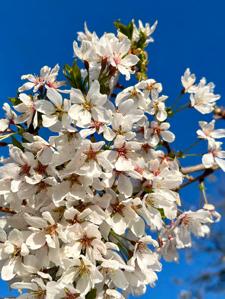
• Prunus ‘Snow Showers’: a glorious, weeping flowering cherry which also gives some eyepopping autumn colour!

• Freesia River Series: short, strong-stemmed freesia with the usual sumptuous scent.

• Liatris spicata ‘Kobold’: a classic and easy to grow perennial, with great flower power. A veritable bee magnet too!

• Cherry ‘Celeste’: naturally dwarf, so ideal for small spaces with super tasty, sweet fruits too.

• Iberis ‘Mermaid Lavender’: a frothy filler with the most beautiful lilac shade for late spring to summer.

• Lobularia ‘Bicolour Lilac Stream’: a superb choice for the best hanging baskets ever, plus you’ll love the honey scent.
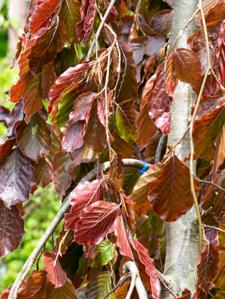
• Fagus sylvatica ‘Black Swan’: an incredibly elegant tree which takes up very little space – I love the foliage.

• Xerochrysum Granvia R Series: grow-your-own dried flowers on your balcony, with these super long-lasting colours.
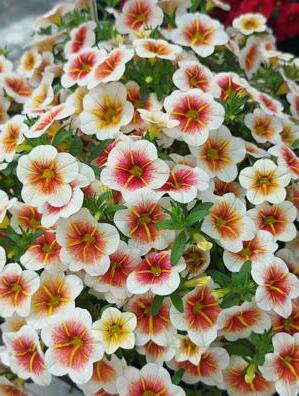
• Calibrachoa ‘Callitastic Cappuccino’: bedding and patio plants can also be great for pollinators –plant a few of these cuties!

• Eucalytpus gunnii ‘Azura’: super hardy and very versatile, it behaves itself in a container or small urban space.

• Nepeta ‘Cat’s Pajamas’: give your furry friends a treat with this compact cat mint.
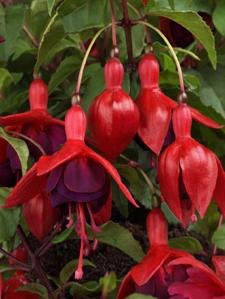
• Fuchsia ‘Janie’: nectarrich blooms and tasty red berries keep many creatures busy through the summer months.
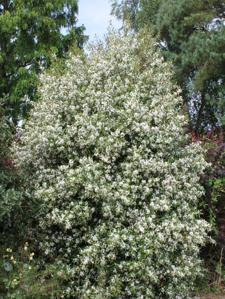
• Hoheria sexstylosa ‘Snow White’: a special evergreen tree that has snowy-white blooms in late spring to early summer.
Garden season ready
This is one of the most exciting times of the year as there are plenty of things to do outside


Tomatoes in beds, pots, grow bags or greenhouses will be growing rapidly, perhaps setting their first trusses of flowers. These plants like consistent moisture, so water regularly. Feed your tomato plants with Big Tom Super Tomato Food for a bountiful harvest.

Roses will soon start their long summer displays. Most roses like airy, sunny sites, so make sure quick-growing shrubs or perennials do not encroach.
Keep your roses growing well; as the early displays begin to fade keep on top of deadheading, apply Westland High Performance Rose Feed, and top up with a mulch of farmyard manure.
Sun-loving plants such as agapanthus, rosemary and lavender (below) are best planted in late spring or early summer, in free-draining soil. They will need to be watered through dry spells. Feeding them will help to establish strong roots.

Win the fight against unwanted weeds with the best tools for the job. Most annual weeds are easily removed by hand, or you can use a hand fork or hoe to help loosen roots. Leaving weeds on the soil surface in hot sun kills them and they are then easily composted. Try to remove weeds before they set seed.

Protect your roses from blackspot and support their health both inside and out. The Westland Rose 2-in-1 Feed & Protect comprises two bottles – the first feeds to ensure vibrant flowers and greener foliage. The second contains a specially formulated protection concentrate. There is also added calcium and sulphur to improve resistance to disease.

Take your displays to the next level
Choosing the right compost for your containers and baskets is vital to give your plants the best start.
Boost All Purpose Compost has water-saving granules to keep your plants hydrated.
Feeding containers and basket displays is essential at this time of year. Westland Boost is a multi-purpose feed that will maintain growth whilst maximising flower production.


Bye-bye frosty nights
It should be safe to move tender plants – such as angel’s trumpet (Brugmansia) or century plant (Agave ) – to a sheltered spot outside. They will need acclimatising gradually, so harden them off over a couple of weeks, standing pots out on mild days and moving them indoors at night.
Sweet peas will be starting to bloom: keep cutting the deliciously-scented flowers for indoor displays to ensure the flowers continue throughout summer. They’ll also benefit from regular feeding with Westland Boost All Purpose Liquid Plant Feed because it is high in potassium and trace elements, encouraging the plant to produce even more flowers so they continue to bloom all season long.

Applying feed to your lawn will give it a great boost in spring and is most needed on those well-worn areas which are kept neat, tidy and weed-free. Apply fertiliser when the grass is growing actively and do so at the recommended rate, ideally in cool, moist conditions.

Before planting vegetables, take time to improve the soil using Westland Farmyard Manure, soil improver, mulch or home-made garden compost if you have some –it’ll result in healthier plants that put on stronger growth, as well as bigger harvests.

Getting under control
Wisteria plants will have started making long, whippy shoots. Some of these can be retained if you want the plant to get bigger, but otherwise cut them back to about six leaves. Repeat this through summer as wisterias are vigorous, quick-growing plants.

Summer-sun colour
Now is the time to plant out summer bedding and tropical displays. Ensure the plants are hardened off before putting into their final position. Make sure your soil is in good condition before planting out: try Westland Bio-Life Soil Improver which has blends of manure and barks to improve soil structure and fertility. Don’t forget to keep plants well-watered and feed regularly.

BEST FOR aerating
Lawn aerator: helps to prevent your lawn from becoming compacted underneath. The hollow tines remove soil to allow air, water and nutrients to get to the roots of the grass, which helps stimulate healthy growth.

BEST FOR thickening
tidy lawn

BEST FOR edging
Edging iron: this handy tool eliminates the need to bend down and helps reduce back strain. Simply press down on the tread plate to create neat edges around lawns and borders, making your lawn edges look pristine!

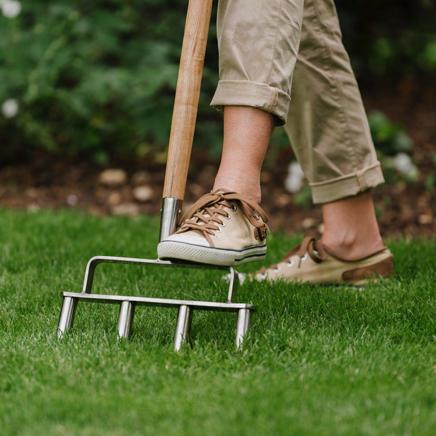
BEST FOR scarifying
Scarifying rake: this tool removes moss and thatch, which is important to ensure water and nutrients reach the roots of the lawn. Improved air circulation, water absorption and fertiliser efficiency will help your grass grow greener!
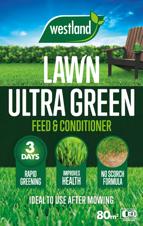
BEST FOR greening

BEST FOR all-round care

BEST FOR removing weeds
Hand corkscrew weeder: makes light work of pulling weeds out of lawns, ensuring they won’t re-grow. Place the end of the tool over the weed and turn it clockwise so the corkscrew wraps around the weed, then pull it out steadily.

BEST FOR pets & children
SafeLawn: this fertiliser is made using natural ingredients so your children and pets can safely use the lawn after application. Top picks for a perfect lawn
Lawn Thickener Feed & Seed: delivers a blend of fast and slow-release nutrients, alongside lawn seed, that will grow and fill sparse patches.
Ultra Green: this features an iron and magnesium supplement to provide rapid deep greening action in just three days.
Aftercut All In One Lawn Feed, Weed & Moss Killer: a triple action lawn treatment that greens and feeds your lawn, whilst controlling weeds and moss.

As temperatures rise over the coming weeks, make sure your lawn is match-fit to deal with everything the weather throws at it
There’s no finer sight in summer than a lush, green lawn. A manicured sight makes gardens appear picture perfect and sets the scene for entertaining and lazing around. But in our changing climate, nature’s green carpets need a little more TLC.
When grass grows at a slower rate during hot, dry weather, it’s not necessary to mow as often. In fact, cutting a lawn too low during extreme conditions can make grass more susceptible to drought. Use a medium setting on your lawn mower during normal summer conditions, but allow grass to grow longer during heatwaves. This is because longer grass encourages deeper rooting, while also shading the soil beneath.
Heavy wear-and-tear can take its toll on lawns, so that’s why it will benefit from regular feeding to keep it in top condition. Applying an organic, child and pet friendly lawn feed, such as Westland SafeLawn, every three to four weeks until October (when grass is actively growing) will green lawns up and encourage a dense growth that crowds out weeds and moss. This treatment boosts nutrient uptake by roots and can even be used on young lawns.
If your lawn turns brown in times of drought, don’t worry – the majority of a grass plant lies beneath the
soil surface in the form of roots, so there’s no need to water it. Lawns that were sown in spring are an exception because they won’t have developed such a deep and extensive root network. Water little and often, first thing in the morning, when temperatures are lower, or after the sun has gone down at night.
Lawn weeds compete with grass for moisture. A hand weeder makes it a breeze to pluck taprooted weeds such as dandelions from lawns. Broad-leaved weeds such as daisy, buttercup, white clover and dock can be spot-treated with a lawn weedkiller, such as Resolva Lawn Weedkiller Extra Ready to use, that quickly eliminates the weed without harming the surrounding grass. Suitable for use on any lawn that’s been established for at least six months, spray on a warm, sunny and calm day when rain isn’t expected for 24 hours.
Grass can creep from lawns into borders, resulting in an untidy appearance. A Kent & Stowe Edging Iron creates a neat distinction between lawns and borders. It’s a simple trick to make the lawn look good, whatever the weather throws at you!
For more on lawn-care advice: gardenhealth.com/hubs/lawn-care
Overseeding is an essential annual lawn task. It will help improve the colour, reduce weeds and moss, and give you a thicker, denser lawn. Mow first, rake to remove any dead grass or moss, then use a garden fork or aerator to spike over the entire lawn. Apply a layer of lawn seed such as Gro-Sure Smart Lawn Seed. Keep the lawn watered over the next couple of weeks while the new shoots come through.

Lawns are constantly walked on, played on and generally subjected to a lot of wear. Using the right lawn feed will help replace lost nutrients as well as keep weeds and moss at bay. At this time of year, you want to use a feed that is safe for pets and children, and will encourage shoot growth, (such as Westland SafeLawn) as this will provide your lawn with all the nutrients it needs.
Help keep your lawn in tip-top condition with a triple action treatment such as Aftercut All In One Lawn Feed, Weed & Moss Killer. This treatment not only greens and feeds your lawn but also effectively eliminates weeds and moss.
When trying to create the perfect thick and luscious lawn, bare patches can be a problem often caused by pets or children. Westland Aftercut Patch Fix is an easy-to-use grass seed, feed and seeding soil to repair patches and neutralise pet damage.


There can be so many types of compost on offer, so which do you use?
Most of us buy pre-bagged composts for growing the remarkable range of plants in our homes and gardens. Modern composts have been formulated to help plants thrive, and some are tailored to the needs of different types of plants. Choose the ideal compost to keep your flowers, fruit, veg, shrubs and trees at the peak of perfection throughout the seasons.
Multi-purpose: a great all-rounder with a host of uses. From potting-on young flowers and veg plants to filling pots, window boxes and hanging baskets, these general-purpose mixes are ideal for summer bedding and hungry edibles. A quality blend will contain enough fertiliser to keep plants fed for at least a month, but after that it is recommended to feed with good quality feed such as Boost All Purpose Liquid Plant Feed. The specific formulation helps deliver a balance between drainage and moisture-retention.

Seed sowing: this is a fine blend that enables close contact with each seed for faster germination. It is formulated to retain moisture and nutrients. Seed compost will be low in nutrients, which is a good thing because it allows seedlings time to establish without becoming leggy. Effective drainage is essential for healthy germination and to prevent damping off (which causes seedlings to rot). This compost can be used for root cuttings too.

Baskets and containers: the compost nestling inside your hanging baskets and containers is the powerhouse behind brilliant container and hanging basket displays. Hanging baskets and containers offer little space for roots to stretch their legs, so it’s vital that compost is packed with nutrients and formulated to cling on to moisture.

Boost All Purpose Compost is brilliant at holding onto water so helps prevent containers drying out.

Matching the right compost to the right plant will ensure it gets the nutrients it needs and the best chance in life.
Historically, most composts included peat. Today, most are sold without peat in them, making them ‘peat free’. Peat free compost may look and feel different to peat-based products that some gardeners are used to, plus you might also notice a difference in how your plants respond to this type of compost. But with a few simple things to be aware of, peat free composts will deliver all the benefits your plants need – and help the environment too.
• What’s in it? Different brands use different ingredients to form their peat free composts – some popular ingredients include a mix of wood fibres, coir, loam, sand and grit. Westland composts contain a carefully blended mix of ingredients at the ideal ratio to create the perfect structure for plant roots.
• How do I water? Peat free composts have a more open, porous structure, meaning they may benefit from more frequent watering – but, not necessarily a larger amount of water. Check below the surface of the compost by pushing your finger into it to feel the moisture: it may well be dry on top while deeper down it is still perfectly moist. Peat free mixes are easy to rewet once they’ve dried.
Ericaceous: acid-loving plants such as azaleas, blueberries, camellias and rhododendrons won’t tolerate alkaline conditions and need a compost that’s free from lime. If grown in the wrong compost these plants will suffer yellowing leaves and poor growth.

Westland Ericaceous Planting & Potting Mix is enriched with iron for lots of green, glossy foliage and enriched with six months of feed for lush, season-long flowers.
Rose: the nation’s favourite flower deserves great compost, whether you’re using it on the ground or in containers.

Westland Rose Planting & Potting Mix contains zinc complex to strengthen plants from the inside out, building their resilience to pest and disease attack. This compost also has added sulphur, which is the key to helping reduce a blackspot outbreak.

• How does it look? Peat free composts can have a lighter, more open structure than conventional composts. It may also be a little lighter in colour and even smell different to peat-based composts.
• Do I need to feed? Yes. These composts may not have as many nutrients readily available, so regular feeding is essential. This, combined with sensible amounts of watering, should ensure successful plant growth. Boost All Purpose Liquid Plant Feed is formulated specifically for use on peat free, peat-reduced and peat-based composts.




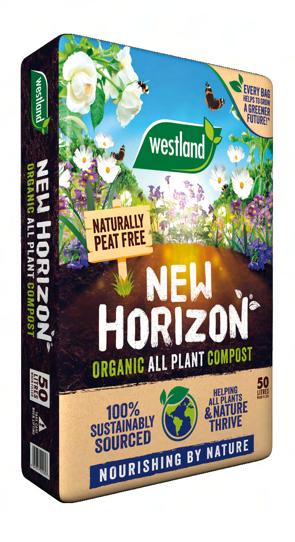
For your best ever garden, Westland’s range of compost is here to help. From traditional Jack’s Magic, to organic all plant New Horizon, there is a compost for every gardener.
Visit gardenhealth.com or scan me for gardening inspiration and advice.
Scan
Feeding plants throughout the growing season holds the key to bumper displays of flowers – and bountiful harvests of fruit and vegetables
It’s vital to feed from spring onwards, to replenish nutrients that have been washed away by months of winter rain. Feeding your plants helps give them all the nourishment they need to allow them to burst into strong and healthy growth. Here are five top feeds that will transform your garden into a horticultural haven!
General-purpose: suitable for all flowers, fruits and vegetable plants, a general-purpose liquid feed will ensure your plants are carpeted in colourful and vibrant blooms all season long, as well as giving your vegetable plots a bumper harvest for you to enjoy. Feed throughout the growing season.

Try: Westland
Boost All Purpose Liquid Plant
Feed is enriched with the right nutrients so your
*Bedding plants vs unfed.
Aftercut All In One
plants will give you four times more blooms*.
Tomato feed: treat hungry tomato plants to a potassiumrich liquid feed, and trusses will be laden with sweet, juicy crops. Tomato feed is enriched with magnesium and iron to support plant health, as well as being rich in seaweed to encourage healthy root growth.

Try: Westland Big Tom Super Tomato Food
Balanced feed: a granular fertiliser such as Growmore delivers equal amounts of nitrogen, phosphorous and potassium for superb flowers, shrubs, trees and crops. It can be used as a top-dressing or worked into soil.

Try: Westland Growmore

Ericaceous feed: a must for acid-loving plants such as azaleas, camellias and rhododendrons. Liquid feeds contain potassium for longer-lasting, fragrant blooms and magnesium for greener, glossier foliage. They’re also enriched with seaweed to give you stronger plants, too.
Try: Westland
Ericaceous High Performance Liquid Plant Food
Try one or a combination of these easy-to-grow blooms

Agapanthus ‘Fireworks’ is a superb African lily, bearing large heads of blue-flushed, white, trumpet-shaped flowers on 60cm stems above strappy, evergreen foliage. Heat-tolerant, it thrives in sun.

Salvia ‘Amistad’ is a king of perennials, bearing upright flower stems of tubular, dark purple-blue flowers. Treat it to fertile soil in a sunny spot for brilliant blooms on aromatic stems, peaking from early August.

Lawn feed: spring lawn feeds revitalise tired turf and deliver a balanced amount of nitrogen, which helps to thicken and green the grass. It is formulated to boost root systems, making grass more resilient to stresses like droughts and heatwaves, while banishing moss and weeds. Try: Westland Aftercut All In One Lawn Feed, Weed & Moss Killer

Crazy for daisies?
Look no further than low-growing Mexican fleabane (Erigeron karvinskianus): pinkflushed, white daisies will dance in the summertime breeze, thriving in sun or part-shade.


Powered by PlantSenseTM Technology, Boost will give you four times more flowers than watering alone, plus more fruits and veg. Rich in seaweed and boosted with extra potassium for healthy growth, it brings you your best-ever results when growing flowers, fruits and vegetables. With Boost in your watering can, you

There is a fantastic range of ornamental plants suitable for direct sowing at this time of year, including these five beautiful flowers. For best results, prepare the area by removing weeds and stones; rake soil to be fine and level; and then sow. Most of these plants should be sown into pre-watered soil and covered with a little more soil to coax seeds into life.
1 Pot marigold (Calendula) are easy, hardy annuals perfect for beginners, bearing single or double flowers in dazzling yellow or orange shades over a long period. A sun-soaked spot is essential.
2 Love-in-a-mist (Nigella) is pollinatorfriendly and ideal for cutting. This charming annual is adored for its wispy foliage and jewel-like flowers in shades



of blue, pink and white. Sow in a sunny, well-drained spot that’s not too dry or hot. Sowing in semi-circular lines creates a wonderfully natural effect.




3 Poppies have gorgeous, papery blooms – nothing beats them for cottage garden-style charm. They’re best direct-sown now, be they California poppies (Eschscholtzia), opium poppies (Papaver somniferum) or wild poppy (P. rhoeas). Choose a sunny, open place.
4 Cornflowers (Centaurea cyanus) are rich blue, pink or white, classic summer blooms. Insects adore their flowers while birds will feast on their seeds. This popular wildflower is simple to grow: sow directly into a sunny border now, scattering seeds over the soil and watering well.

“I like to mix planting in baskets, so as well as seasonal bedding colour, consider growing tomatoes, strawberries, chillies and herbs.”
Chris Collins is a keen balcony gardener and allotmenteer, and director of CM Collins Horticulture.



5 Corn cockle (Agrostemma githago) are best in early summer. At the tip of each stem, a large, showy, red-pink flower develops with contrasting dark markings. To enjoy these charming, bee and wildlife friendly annual wildflowers, scatter seeds directly into fine, well-drained soil in a sunny location, water well and enjoy these blooms all summer long.
As spring starts to make way for the summer months, everybody’s spirits will be rising. The days are growing longer and I for one want to spend as much time outside as possible.
Although the bulk of my seed sowing has been done, I still have some important crops to get on the go, and I prefer to sow these in early May. Tender edible crops –such as runner beans, courgettes, squash and sweetcorn – all benefit from being sown now as they prefer warmer months. They love being planted right at the end of May, once the soil has warmed up, which in turn encourages rapid root growth and plant establishment. These food crops often prove to be the most bountiful of all, and by July their generosity will be there to pick.
May can also be capable of giving gardeners a few curve balls: late air or radiation frosts can hit, occurring after a warm day due to rapid heat loss when the sun goes down. This type of frost can check plant growth, so it’s worth buying some garden fleece which can be placed over any vulnerable plants on nights when the temperature is too cold. Cold easterly winds can also hit in May so always keep an eye on the weather during this transitional month.
One thing I can get on with is making up my hanging baskets for the summer. I’m a big balcony gardener and baskets are a great method of making use of limited space. I prefer wire baskets as this allows me to plant through the sides as well as the top. I plant in layers, staggering

One of Chris’s ingenious ideas is to plant up a hanging basket with herbs and fruit.
each plant through the wire frame which means it will be invisible to the eye once everything gets growing. I also like to mix planting in baskets, so as well as seasonal bedding colour, consider growing tomatoes, strawberries, chillies and herbs.
The arrival of summer means we will be enjoying the results all of our spring endeavours, so make sure you take time to sit back, enjoy a glass of wine and munch on some fresh produce. Happy gardening!
Growing orchids can sometimes be tricky, and they are often seen as throw away plants once they lose their flowers. Whilst they may be stubborn, they will often reflower if you follow some simple steps.
Location
To get your orchid flourishing with flowers it is essential to provide good light and a warm windowsill, but keep them out of direct summer sun.
Watering
The best way to water an orchid is over the sink, letting the water drain away before returning to its decorative pot – this way the greygreen aerial roots can also have a soaking. Never let your orchid stand in water or the roots will quickly rot.
Potting mix
When it comes to repotting, make sure you use a specialist mix which
will typically feature bark to allow for good drainage. Look out for Westland Orchid Potting Mix, it’s rich in pine bark, freedraining and has added zinc to promote more root growth.
Pruning
To encourage repeat flowering, cut faded flower spikes back to a side shoot, or if the whole flower stem dies, cut it back to the base and wait for another to grow.
Feeding
It is essential to feed plants regularly in the summer using a concentrated feed such as Westland Orchid Feed which contains trace elements to encourage flowering. Or try Westland Orchid Water –this is a ready-to-use mixture of essential nutrients and purified water. Westland Orchid Mist is also available to help orchids flower for longer and keeps leaves moist, clean and healthy, with a natural shine.
To keep your indoor plants happy and healthy, keep an eye out for these four common foes


1 Fungus gnats: also known as sciarid fly, thrive in wet compost and are notoriously difficult to remove as they lay eggs beneath the surface. Try repotting your houseplants in Westland Houseplant Potting Mix: this dry, free-draining mix prevents overwatering and deters flies.
2 Aphids: sap-sucking flies can be seen at leaf shoot tips.

Orchid essentials
Three products to keep your orchids happy and healthy



TOP TIP
Westland Bug Guard spray controls pests, is pesticide-free, and improves your plant’s natural d efences.

New growth is weak and distorted, and if left untreated your plant will suffer from sooty mould. Squash or wash insects off, or spray with a bug stop, like Westland Bug Guard.
3 Red spider mite: tiny, spider-like, sap-sucking creatures that infest plants, usually below leaves, where they spin webs. With large infestations, plants turn yellow, leaves fall and


growth is weak. The mites are often common in hot, dry places so increase humidity or spray with a bug stop.
4 M ealy bug: these are shieldshaped insects covered in white wax clustering at shoot tips. Leaves yellow, wilt and fall, and sooty mould appears. Ideally, catch these early – squash them and wash off the insects.
Add beauty to your living space whilst helping cleanse the air in your home
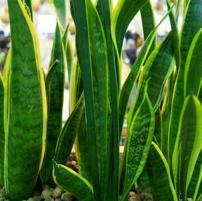
Snake plant (Sansevieria) A hardy plant with sword-like bright and dark green leaves, it thrives on neglect and sporadic watering. It stores oxygen during the day to release overnight. Feed once a month with Westland Cacti and Succulent Feed.

Peace lily (Spathiphyllum) This clump-forming plant has lance-shaped green leaves and white flowers. It doesn’t like it when the compost dries out, so consider using a watering indicator that alerts you to when plants are thirsty.

Aloe Vera (Aloe barbadensis) A handsome succulent with fleshy, grey-green, sometimes spotted leaves. Keep on a sunny windowsill. Water when compost surface dries; use Westland Cacti and Succulent Feed every two weeks.

Pothos (Epipremnum aureum)
Cascading or climbing plant that likes to be away from summer sun (leaves can burn), so place near a window. It enjoys humidity, so stand on a tray of hydroleca.

Fiddle leaf fig
(Ficus lyrata) This bold houseplant has glossy, violin-shaped leaves. Place in good light away from direct sun. Keep compost moist; feed fortnightly with Westland Houseplant Feed.
Spring is when most houseplants start actively growing again, responding to longer days and in many cases enjoying a welcome break from the dry air of central heating. Now is the perfect time to check on the health of your houseplants and repot them
Signs that a houseplant is struggling include yellowing foliage, excessive leaf loss, sluggish growth, poor flowering as well as a mass of roots emerging from the base of pots (known as being pot bound).
Compost can become depleted of nutrients over the years and stressed plants are more prone to bug infestations. You should repot houseplants into fresh compost every two to three years, as this will replenish the nutrients that your plant needs to thrive. Westland Houseplant Potting Mix

Using hydroleca as a top dressing.
is enriched with Seramis® granules that absorb water and nutrients, and then release them to the plant as and when they need it. It also incorporates zinc compost to stimulate up to 80 per cent more root growth, helping to reduce stress after repotting.
1 Choose a container that’s only slightly bigger than the current one, around three to five centimetres larger in diameter. A pot with plenty of drainage holes is essential, to reduce the risk of overwatering.
2 Have the right compost ready. You can use Westland Houseplant Potting Mix for most common houseplants, whereas more exotic plants such as bonsai or cacti will require a specialist mix that is formulated for their individual and specific needs.
3 To remove the old pot, hold the plant by placing your fingers over the surface of the compost at the base of the plant. Turn it on its side and gently ease the root ball from the pot. Where roots have spiralled, use your fingers to tease old compost away and remove any dead or damaged roots.
4 Add a layer of Westland Hydroleca granules to the bottom of your new houseplant pot before adding compost. This will help to prevent waterlogging and improve drainage.
5 Add a couple of handfuls of compost, then sit the plant in the new pot,

Place 2cm of hydroleca at the top and bottom of your plant pots to help with moisture control.

Add to your watering can to give your houseplant all the essential nutrients it needs.

Simplify watering: add the indicator to your plant’s compost and it will turn red when it’s time to water.
adding or removing compost so it sits around 1cm below the rim of the pot. This will prevent water spilling over the edges of the pot when watering.
6 Fill the gaps at the sides of the root ball with the fresh potting mix and gently firm down the compost; water well.

7 Top dress with hydroleca as this will help to prevent fungus gnats.
Scan the QR code for more houseplant care advice.


Two of Britain’s most celebrated actors, a husband and wife duo of more than 40 years, share their love of gardening and why they passionately support the Greenfingers Charity. Interview
by Chris YoungPeople often say that gardens are a personal haven and a respite from the world – and that couldn’t be more true for Imelda Staunton CBE (most recently seen for her touching performance of the late Queen Elizabeth II in The Crown) and Jim Carter OBE (possibly best known for the stern but fatherly butler Mr Carson in Downton Abbey).
And with a film, television and theatre credit list of more than 300 titles between them, you may assume there’s not much time for anything else. But the affection they have for their west London garden is clear. “We love our garden very much,” says Jim. “We’re so
lucky to have all our plants, seating areas, the pond and the view of the local cricket pitch.”
The garden is immaculate: long and thin at the back and wider at the front, every inch of this corner plot is used, with small terraces and planting areas making the most of the different levels. From hellebores to hostas, roses to dahlias, climbers to small trees, there is a plant in every bit of soil. “We love brighter colours,” explains Imelda, “especially in the sunnier parts of the garden where we have dahlias, cannas and lilies. Oranges and reds are fine by us!”
Not only are they private gardeners, but they are
PHOTOGRAPHY: NEIL HEPWORTH
Left: Dotted amongst the variegated ivy are a quirky collection of bird boxes.
Below: Jim particularly loves succulents, here basking in the warmth of the kitchen bay window.

“The British are meant to be a nation of gardeners, but if you look out of a train window, you’d think we’ve become a nation of trampolinists!”
public patrons of Greenfingers, the charity that designs and constructs beautiful gardens for children’s hospices. “We’re really proud patrons,” they explain. “It’s the 25th anniversary of Greenfingers this year and in all that time, they’ve made nearly 70 gardens that offer sanctuary and respite for patients, family and friends of children with life-limiting conditions.” Jim says: “It’s a smallish charity with really specific aims, and we enjoy seeing the actual changes that Greenfingers makes on the ground. The charity also ensures there’s the infrastructure available to care and maintain for these gardens.” Imelda adds that, “the gardens are truly for everyone and allow people to move around, whether in wheelchairs or beds, and be outside with nature”.
But where did their shared passion for gardening come from? “Neither of us came from a gardening family,” explains Imelda, “in fact my family didn’t have a garden but Jim’s did when he was younger living in Harrogate.” Instead, they are self-taught, happily bringing up their actor daughter Bessie (now 30), over the years ensuring she had a “proper childhood of being outside”, as Imelda puts it. Clipped hornbeam hedging, well-tended shrub roses, plenty of spring-flowering woodland planting, and choice Japanese maples in containers shows their interest and skill in keeping their seasonal interest going.
“We love gardening books and have a great collection of them,” says Jim, “with the late Christopher Lloyd, of Great Dixter, being a particular favourite.” Whether in
the greenhouse or shed, summerhouse by the pond or shady planting at the end of the garden, there is plenty to do. Even though it’s in one of the busiest cities in the world, this London garden feels like it could be happily in the countryside.
Embedding gardening – and a wider understanding of plants – into the National Curriculum is another passion. “The world has changed and education needs to catch up,” Jim says. “Schools need to be a place you want to go to, and we need to stop the disaffection in education. We need less screen time, and more green time.” Ideas of bringing the syllabus to life through plants and growing; of letting teachers feel less constrained; and of linking children to nature, are all examples the couple suggest as ways of enriching society and children’s education. “The British are meant to be a nation of gardeners, but if you look out of a train window, you’d think we’ve become a nation of trampolinists!”
Having lived with their garden for 30 years, they know every inch of it. “Wildlife is particularly important,” says Jim. “From the pond’s frog spawn or dragonfly larvae – or the fact that we had 36 species of birds visiting the garden when we first moved in – we love to look and study all the life in the garden.” A pair of binoculars by the kitchen table, two sets of secateurs by the back door, and a genuine enthusiasm for being outside amongst the plants make Jim and Imelda very real gardeners. Actors they may be, but gardeners they are at heart.
If you were a plant?
Jim: one of the ‘Bishop’ dahlia series
Imelda: star jasmine
Favourite flower colour?
Jim: Californian poppy
Imelda: Geum ‘Fiery Tempest’
The one tool you wouldn’t be without?
Jim: long-handled scissors
Imelda: snips
Ornamental plants or veg?
Both: flowers
Happiest gardening memory?
Both: sitting in the summerhouse watching the wildlife
First plant you remember growing?
Jim: pelargoniums
Imelda: rose ‘Rambling Rector’
Drink of choice in a garden centre?
Both: coffee
More about Greenfingers
Greenfingers was established in 1999 and has created almost 70 gardens in children’s hospices across the UK. The charity works closely with children’s hospices to ensure life-limited children, families and carers who spend time in hospices can enjoy precious time outside.
This year they are opening three new Greenfingers Gardens at Derian House in Lancashire, The Nook in Norwich, and Demelza Hospice in Kent.
Each Greenfingers Garden is unique, but they are all therapeutic and social spaces, professionally designed to be inclusive and specific to that hospice. For more information and ways to donate, visit greenfingerscharity.org.uk

As the growing season gathers pace, use these top tips to grow the tastiest crops
The secret to turning your vegetable harvest from a humble handful to an abundant banquet lies in regular feeding.
Treating plants to a potassium-rich feed, such as Big Tom Super Tomato Food, will boost yields for tomatoes, cucumbers, courgettes, strawberries, peas and sweet peppers.
Tomatoes need feeding every 10 to 14 days, once the first truss of fruit has set (when the flowers start to swell into green fruit) on greenhouse plants, and when the second truss has set on tomatoes growing outdoors.
Runner beans are best fed with a general-purpose vegetable fertiliser such as Westland Organic Vegetable

Liquid Plant Food. Once plants begin to flower, switch to feeding fortnightly with tomato food.
If you are growing lettuce, chard or spinach, opt for a balanced liquid fertiliser that contains equal amounts of nitrogen, phosphorus and potassium (NPK). Leafy crops such as cabbage and kale respond to high-nitrogen fertiliser, which encourages tender leaves.

When courgettes begin to swell, feed every 10 to 14 days with a general-purpose vegetable liquid feed, or tomato food.
Tasty edibles will crop happily in large pots in a sunny spot. While they will succeed in multi-purpose or John Innes No.2 compost, filling containers with New Horizon All Vegetable Compost – which is tailored to meet their demands – holds the key to bumper harvests.
Planting tomatoes into growing bags, such as the Big Tom Tomato Planter, enhances crop quality and encourages abundant fruiting – and tomatoes will thrive in highnutrient John Innes No.3 compost, too.
If you’re growing edibles in the ground, now’s the time to get soil in tip-top conditions. After a wet winter, replenishing soil nutrients is vital: incorporate well-rotted manure or garden compost, spreading a deep layer (4cm) over the soil surface and working it into the soil. The addition of organic matter enriches soil with nutrients that edibles need to perform.

Carrots
Nantes 2
Sow now and harvest in late summer, perfect for your salads.

Radish Unwins Crunchy Mix
Ready to harvest in as little as six to eight weeks.

Courgette Firenze F1
Great for fresh autumn veg from your garden.

Lettuce
Baby Leaf Mix
Sow every couple of weeks to ensure a continuous harvest.
Pick up any plant food and you’ll be greeted by the term ‘NPK’ but what does it mean? Each letter stands for one of the three essential nutrients for healthy plant growth; understand the benefits and you’ll be armed with knowledge to choose the right plant food.
You can encourage growth, flowering, cropping and root development with a feed such as Growmore, which is a tried-and-tested, balanced, general-purpose feed. But many plant feeds contain varying levels of NPK depending on their purpose...
Nis the symbol for nitrogen, which promotes fresh, leafy growth. High nitrogen feeds are often applied in late spring and early summer to spur plants into putting on growth after the risk of young foliage being damaged by frost is over. Spring lawn feeds are commonly rich in nitrogen, too, transforming tired turf by encouraging lush, green growth ahead of summer.
Pis for phosphorus, which stimulates root development and helps shoots to grow, too. Young plants that need to develop a healthy root system, as well as root crops, benefit from feeds that are rich in phosphorus. Westland Fish, Blood and Bone is a classic example of a high phosphorus plant food, as is bone meal.
Kis for potassium, aka potash, which turbo-charges flowering and results in abundant harvests of fruit. Big Tom Super Tomato Food, for example, is rich in potassium, spurring plants into blooming profusely, and more flowers means heavier crops! Liquid feeds that are rich in potassium are ideal for use on summer bedding plants, encouraging an abundance of flowers.

“Each letter in NPK stands for one of the three essentials nutrients for healthy plant growth”



As temperatures rise, gardeners should be on red alert for slugs and snails, which thrive in warm, damp conditions. Left unchecked, they can quickly devastate plants.
Try not to overwater soil where young edibles are growing. Take extra care if you’re watering a veg plot in the evening, because slugs and snails adore moist overnight conditions.
To reduce the risk of damage, use a torch at dusk to collect slugs and snails, or use Growing Success Slug & Snail Traps close to vulnerable plants. Organic slug pellets such as Growing Success Slug Barrier Pellets will effectively keep populations down, while attaching Growing Success Slug Copper Tape to pots will throw a defensive ring around edibles growing in containers. If your problem still persists, as a last resort you could try Growing Success Slug Killer Advanced, which is certified for organic use.




Kent & Stowe’s premium tools are highly regarded for their durability and functionality, but what inspires this expert craftsmanship?
The name Kent & Stowe celebrates two of history’s most influential gardeners. William Kent is regarded as the founder of the English landscape movement, famous for his work at Stowe Gardens in Buckinghamshire. His legacy at Stowe continued with Lancelot ‘Capability’ Brown who became famous across Europe, working on more than 170 landscapes that seamlessly blended the natural with the manmade. The nickname, “Capability”, came from his habit of surveying a property and remarking on its “capabilities” for improvement.

This ethos inspires Kent & Stowe to create tools from the finest materials, blending traditional designs with the latest manufacturing techniques. The popular Capability Trowel has a handle with a metal hammer for knocking in canes, and a blade with a serrated edge for opening compost bags and cutting roots, while the superb Eversharp secateurs have blades made from ultra-hard steel. Using Formula 1 plasma coating, they are twice as sharp and last six times longer than other blades.
The full range includes digging, cultivating and hand tools, made from high-quality stainless or carbon steel and crafted with precision to ensure longevity and performance.

Sign up to the K&S Club

Kent & Stowe Eversharp All Purpose Secateurs.
If you love gardening, you'll want to sign up to receive this monthly newsletter.
Kent & Stowe shares gardening inspiration, top tips to get the most from your tools, and regular opportunities to win free kit.

When it comes to cultivating a flourishing garden, having the right tools to hand is essential. The choices are typically either carbon or stainless steel. Both have distinct characteristics that appeal to different gardeners, based on their needs and preferences

Stainless steel is made of an alloy containing iron, carbon, and chromium. It is less robust than carbon steel, but has high resistance to corrosion, so these tools are more robust if exposure to moisture is a concern. For most jobs, stainless steel tools will be up to the task.
Rust resistance
This material has superb corrosion resistance due to the chromium which forms a layer on the steel surface, shielding it from moisture and oxidation. For gardeners that prefer low-maintenance tools or seldom use them, stainless steel is ideal.
Maintenance
Stainless steel is easy to wipe down and soil doesn’t adhere to it, while its resistance to corrosion eliminates constant cleaning and oiling. Gardeners looking for hassle-free tools often choose this material.
In conclusion: If you favour tools with a sleek, modern appearance that keep their good looks with minimum maintenance, pick stainless steel.
As we move towards the longer, warmer days of late spring and summer, keeping your plants hydrated is the key to ensuring a thriving garden oasis. A quality watering gun will make your life much easier, providing different watering spray patterns for all the different plants in your garden. We’ve taken a look at three different spray guns from FloPro, each with unique features, so you can choose the one best suited to your garden.
Carbon steel is tough and robust. High carbon content makes it stronger and tougher than stainless steel. For gardeners, this means carbon steel tools are suited to the widest range of tasks, including tough jobs such as digging and slicing through roots.
Rust resistance
It can be prone to corrosion if exposed to moisture or kept in damp conditions. Gardeners who choose these tools will need to prevent rust forming to maintain the strength of the carbon steel and keep their tool looking its best.
Carbon steel tools need attention if they are to remain in good condition. Soil should to be brushed or washed from blades after use, and tools dried with an old towel before storing. Occasional oiling also helps prevents rust.
In conclusion: Higher maintenance but the traditional, rugged look of carbon steel tools add a sense of authenticity, indicating hard work and dedication.


TOP TIP
The best time to water your plants is either at the start or end of the day.

FloPro Garden Multi Spray
• Seven distinct spray patterns including jet, soft, fan, rose, cone, mist and fill

• Trigger lock, variable flow trigger and rear flow control to give you full control
• Great in the greenhouse

• Robust metal body for durability and protection against the rigours of outdoor use
• One handed water control allows you to turn water on and off and adjust waterflow at the same time with air to create a gentle flow
• One handed water control allows you to turn water on and off and adjust waterflow at the same time
• Ideal for watering plants in pots and containers
Good news! As with all FloPro products, the connectors fit all hose brands so you don’t need to worry about incompatible fittings – these will attach right onto your existing set up.
Spade (1)
Every gardener needs a border spade that slices cleanly into soil, helping to cultivate the ground, excavate planting holes, and improve drainage. A quality spade helps gardeners to keep a straight back, and is also handy for dividing herbaceous perennials.
Fork (2)
A border fork is a true multi-tasker, with its small, slender head allowing gardeners to work precisely among plants. Use it to remove weeds, aerate or turn over the soil, mix in organic matter, create a lovely crumbly soil texture, level the ground, or prepare planting holes.
Potting scoop (3)
The days of delving into bags and trying to extract compost without spilling it on the ground are over! A traditional, deep scoop makes it easy to retrieve large amounts of compost from bags without any mess. Whether you’re filling pots to prick out seedlings or planting-up containers, a scoop speeds up the process. And when you’re not using it for compost, it’s ideal for filling bird feeders with bird seed, too.
Trowel (4)
A must-have for pottering, this essential piece of kit works wonders for getting small plants and bulbs into the ground. It’s ideal for removing weeds, lifting and moving self-sown seedlings, digging a shallow drill in the vegetable garden, or mixing potting compost. A Kent & Stowe Capability Trowel also features a serrated edge and a robust hammer for even more tasks.
Dutch hoe (5)
For speedy weeding, a Dutch hoe is your best friend. The long handle is ideal for reaching annual weeds in tight spaces in borders. Use it in a push-pull motion to slice off unwanted invaders that pop up in between plants and seedlings.
Watering can (6)
Watering cans provide gentle, precise watering. The FloPro Can-Can Watering Can is the first can to connect directly to a hosepipe connector – no need to bend down and hold the hose in place while the can fills. It also has a large filling hole for plunging into a water butt for fast filling.

“Three hours in the garden is equivalent to one hour in the gym.”
Dr Richard Claxton, a GP in Kent, campaigns for the provision of naturebased therapies in healthcare settings





If you’re anything like me, the arrival of warmer temperatures and longer days leaves me itching to get out in the garden, to get busy so my plot can get off to a flying start. But it’s not just the veg plot and borders that will benefit from some attention this spring...
We now know more and more about the benefits that either gardening and/or spending time in nature gives us. And the headline is that time spent out there earns big dividends for our own wellbeing. I know this from managing my own physical and mental health, as well as from the benefits gardening ‘on prescription’ gives my patients. Three hours in the garden is equivalent to one hour in the gym – which is great news for those of you who, like me, never really got on with gyms (or lycra, for that matter!). Gardeners as a group are much less likely to be overweight and their healthier lifestyles and grow-their-own diet is less likely to lead to diabetes. They are also less likely to suffer from dementia, and have lower levels of stress and higher levels of wellbeing.
And for those with established depression, dementia or diabetes, there are real benefits from treatment programmes in garden therapy.
We’re learning fast about the many ways that these benefits work. Physical exercise of course is good for us, as is a bit of fresh air and sunshine to help our vitamin D levels. Contact with the soil gives us higher levels of serotonin in the brain which lifts our mood. And a spell in the garden leads to lower levels of cortisol (the stress hormone), blood pressure and heart rate, but amazingly also higher levels of tumour-killing white blood cells.
But for me the benefits are simpler: I love to lose myself in focussing on each task – be it sowing seeds, weeding, potting on or pricking out. To work with nature in creating a beautiful space, to grow my own food and do my bit (in a small way) to help wildlife and biodiversity, and to come in as the light fades with that good ache that tells me that I’ve done well… these are the things I love the most.
Glorious hanging baskets are a national institution. Follow our easy guide to creating a basket that’s dressed to impress
1 Quality compost is key to a brilliant display. Boost All Purpose Compost is a new, peat free powerhouse that’s enriched with starter feed and Moisture Lock™ Technology to make watering easier.
2 Wire-framed baskets will need to be lined using moss or a pre-formed liner. Moss looks more attractive before plants fill out, but rigid liners are quick and easy.
3 Before filling with compost, place a plastic saucer with a deep rim in the base of the hanging basket. It’ll act as a reservoir, preventing water run-off and keeping plants’ thirst quenched in scorching weather.
4 Part-fill with compost and add trailing plants (Lobelia, Petunia, Bacopa, Verbena and Nasturtium) through holes at the edges, filling gaps around root balls with more compost.
5 Once trailing plants are in position, add more compost and settle upright. Use plants such as delightful African daisy (Osteospermum) and geranium in the centre. Add trailing fuchsias towards the edges. Plug gaps with compost, gently firm down and water well.
6Feeding your hanging basket is essential. Feed your containers with Boost All Purpose Liquid Plant Feed for four times more blooms*, giving you truly beautiful displays.


Impatiens ‘Beacon Mixed’: dazzling busy lizzie in a mix of vibrant shades, offering brilliant resistance to downy mildew.

Petunia ‘Night Sky’: novel purple blooms speckled with white are a head-turner (also try classic Surfinia trailing petunias).

Verbena Enchantment series: jazz up baskets with cascades of red, purple or white blooms.


Fuchsia ‘Eva Boerg’: all-time favourite trailer with masses of pink-and-white semidouble flowers.

Lobelia ‘Sapphire’: cascading plants are carpeted in a profusion of violet-blue flowers over long periods.
Boost All Purpose Compost is peat free and enriched with starter feed. Our Moisture Lock™ Technology makes watering more effective and easier too. Perfect for all containers and baskets, giving them the boost they need for stunning, vibrant floral displays. Use with Boost Plant Feed for 4x

This time of year is perhaps one of the most exciting for watching garden birds, as both resident birds and summer migrants will be busy making nests, breeding and of course feeding. Here are some of the most popular birds this season to bring colour to your garden

Blue tit
A mostly white face with blue and green plumage, and yellow underparts. Did you know that blue tits can lay as many as 13 eggs in a single brood? That’s a lot of chicks in one nest!
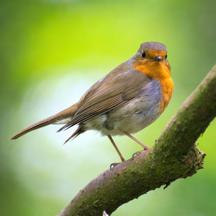
Robin
Red breast, brown back and a lover of mealworms. This popular garden bird’s red breast is a badge of status – young robins don’t get theirs until they gain adult plumage.


Great tit
Black and white head, a yellow/green breast and back. A broad black stripe running down to its belly means it’s a male; females have a narrow, shorter stripe.

Dunnock
Thin beak, orange legs, pale brown mottled belly. Sometimes called a ‘hedge sparrow’ because it likes hedges, but it isn’t a sparrow at all.

Great spotted woodpecker
Black and white plumage and red under tail. Males have a red marking on their nape whilst the females don’t.
Who doesn’t love to see birds feeding in their garden? With a few simple steps, and the right food selection, you can support a whole host of avian visitors
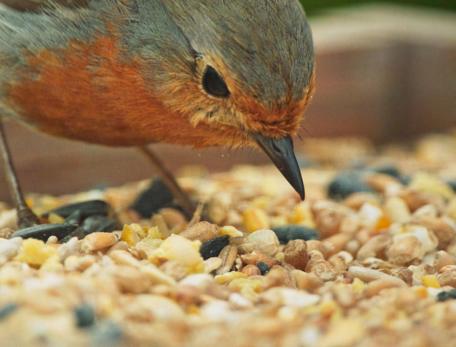
When you start feeding wild birds, monitor how much food is being consumed: if you notice that there’s a lot of food left over at the end of each day, reduce the amount you’re putting out to avoid it going mouldy.
May is the peak of the nesting season for garden birds, so a soft, high energy feed is ideal for small and young birds – try Peckish Extra Goodness Nuggets on your bird table.
Be sure to take it easy on the trimming back of hedges at this time of year – most birds feed insects to their young, and wild parts of our gardens will provide
the richest pickings. If you don't have a wild space in your garden, Gardman Mealworms will be appreciated.
As a general rule, it’s best to put out food at least once a day. Try to provide food at the same time each day, so the birds know when to travel to your garden. It’s better to place several feeders in different areas of your garden, rather than having one large feeder; this will help more birds feed and enable you to use a different type of food in each feeder.
As well as nutritious and healthy food, provide clean water for bathing and drinking. Bathing is essential for most birds as it’s an important element in keeping their feathers in good condition. Many wild bird feeds are a dry food source, so it’s also important that you leave water out for the birds to help them stay hydrated. Always ensure that water left outside is clean – dirty water is prone to passing on diseases.
During hot months, make sure your bird baths are topped up with fresh water as birds will often use the water to bathe in and cool down, meaning it will often get dirty.

Hold off trimming your hedge from March to July to help wild birds nest and thrive…
• The key to attracting the nation’s most loved birds, such as robins, blue tits and great tits, is all in the type of food you offer. These birds have small beaks, so they need softer seeds that are high in energy. Peckish Complete Seed Mix contains 12 different seeds to attract even more colourful birds.
• Whether you’re using a feeding table or station,
make sure it is placed somewhere birds feel safe, not too close to walls or fences.
• If you’re new to bird feeding, try the Peckish ready to use filled feeders, which are made in the UK and ready to go straight into your garden.



Feel the joy of feeding wild birds with Peckish bird food. A perfect blend of seeds.
Grab your brightest pencils and let your imagination







How one school is enthusing young people to know more about their environment, with the potential of a future career in horticulture
Pershore High School in Worcestershire is at the heart of some of the best growing land in the UK. So perhaps it’s no accident that as a school it has its own accredited Horticultural Education Unit.
What is surprising perhaps, is that it was set up more than 10 years ago, and established to fill a need that the local specialist college could no longer meet. In that time more than 60 students have gained horticultural qualifications and some life-building experience. A number of those students have gone on to more specialist horticultural studies – one student even became a finalist in the Young Horticulturist of the Year.
The school’s Executive Head, Phil Hanson (the inspiration behind the project) said: “We were keen that our students gained life experience as well as a qualification, yet I never dreamed that we would have students growing plants for displays at RHS Chelsea Flower Show and BBC Gardeners’ World Live. Horticulture is a fantastic blend of science and art and while sadly it is not part of the National Curriculum, it can be incorporated into so many school lessons.”
The school’s Horticultural Unit has been awarded

“If you need to know why children should garden, why not ask a seven-year-old?”
Accredited Centre status by the RHS, meaning that through a process of teaching, learning, assessment and external verification the students gain nationallyrecognised horticultural qualifications. Students have their own plot where they grow vegetables and flowers from seed, with the produce either going to the school kitchens or being sold. Further crops are grown in the on-site polytunnel so students get an understanding of ‘protected crops’. A small orchard and fruit cage, along with areas of ornamental borders, woodland and informal plantings helps complete the student’s broad experience and plant identification skills. Students gain further experience with visits to growers and nurseries as well as garden centres. A highlight of last term was spending a day at TASK Landscape Academy where students gained experience in bricklaying, paving and other hard landscaping crafts.
Horticulturist Neil Gow, who assists with training and verification, adds: “We are very lucky with the support we get from growers, letting students see how commercial crops are produced. Retailers share with us how their businesses operate, and we also enjoy great

support from a number of the garden manufacturers including Wolf, Westland and Stewart Plastics.”
But maybe Andrew Nockton, Head of School, sums it up best: “We are realising that since the Covid pandemic, even more so than ever, the mental health benefits of working outdoors and with plants cannot be underestimated. Perhaps some of our students will become the stars of the future in helping create a more sustainable environment for us all.”
For many adults, the answers to the question ‘what are the benefits of kids gardening?’ seem obvious. But as someone who is obsessed with getting the younger generation to have a connection with nature, seasonality and growing, I thought I’d ask my invaluable garden helper Winnie (aka my daughter) and give my take to her responses. At seven-yearsold, she is fully qualified to answer such a broad question, especially as she’s been helping me since she was two!
Winnie: “I fell in love with nature” I have watched the connection between Winnie and nature deepen along our gardening journey. Every bug – be it ant, worm or spider –becomes her best friend; she respects every single creature; and has no fear of creepy crawlies. (The latter is a complete saviour for me because I am usually found running across the garden from a rogue bee while she stares at me quizzically….)
W: “Your smile will blossom” This is just pure magic: gardening with Winnie has given us so many beautiful memories that will last a lifetime. The smell of a freshlypicked tomato will forever be in her mind and connect her with gardening for the rest of her life.
W: “I get excited about picking and eating the fresh vegetables I have grown in my garden” Now this has got to be every parent’s dream! I can honestly say that growing our own food has totally changed Winnie’s connection with vegetables. Being there every step of a vegetable’s life –from seed to plate – engages children’s imagination and gives them a respect for food. Knowing how long it has taken and the excitement of picking your first pea is a gift many children sadly never get to experience.
W: “I go out in the garden in every weather” The resilience born from getting your kids outside gardening is second to none. So many children are wrapped in cotton wool. We are outside in all weathers, weeding in the mud, using forks, spades and rakes; this gives confidence to children in using practical equipment and for their dexterity.

You can see from Winnie’s answers that the benefits of gardening are a part of life that every child deserves to experience. We haven’t even scratched the surface with the long list of other benefits, but I can hand on heart say if you haven’t grown food with your kids before, it will not only change their life but also yours. Once upon a time I was an air hostess and now I teach gardening every day and have never been happier – and that is all thanks to growing food with my kids.
August Bernstein is head tutor at The Raymond Blanc Gardening School at Le Manoir aux Quait’Saisons Hotel in Oxfordshire. @august_garden IMAGES:
Down tools, take a seat and have a break from the hard work in your garden and let your brain do the thinking...










QGJJBBGHTWNYBMMMP
IIAJJFONFPECKISHO
BCROUNFOIOKFWAPST
ZEKSUEXZSRFHLHINH
GNINEDRAGTPVILNSO
TPPCHBPYOEISLUIES
NRPEUONNSATEDNROK
XZXRRDEUSWRTATWTU
RZUFIEGOWTSGHUKAG
GXPBHANZXEKHLCMML
UABYREQNNVNSIRZOD
KEJAPNEUIBQIAMFTT
RGPTEPRQEABMSGFJW
YSESXGUWTULIPSVZH
ASORAHTUASOSZKPRU
BLOOMBAWORRAPSPNA
QDOLWKNHDJRBKDGEM
We’ve mixed up some common garden words, so see if you can unscramble them!
Asparagus
Bloom
Boost
Dahlias
Dibber
Gardening
Lawn
Nature
Nest
Peckish
Perennials
Pothos
Salvias
Sparrow
Spring
Tomatoes
Trellis
Tulips
We're offering our readers a chance to win a HUGE bundle of gardening goodies, worth over £250!
Just visit gardenhealth.com/westland-win to find out more and enter. T&Cs apply, please see website for details.
Our round-up of the latest gardening books from DK.com and garden centres

The Money-Saving Gardener
First-time author Anya Lautenbach (@Anya_thegarden_fairy on Instagram) reveals tips and tricks to keep costs down without compromising style or impact. Boost your plant collection for next to nothing with seed-saving and propagation hacks, learn how to repurpose what you have, and make the most of so-called garden “waste”. £16.99

Small Space Revolution
Activist, gardener and community advocate Tayshan Hayden-Smith is on a mission to bring about change, channelling creativity, collaboration and culture. The book is packed with simple ideas and practical projects – from choosing climbers for cover to repurposing plastics to build a greenhouse. Plus ways to connect with nature. £16.99

The Self-Sufficiency Garden
Huw Richards and Sam Cooper have spent two years planning and trialling their self-sufficiency garden in a 10x12.5m plot, and they've worked out the perfect formula. Grow six portions of nutritious veg a day per person, following their realistic and flexible month-by-month growing plan. Check them out on Instagram and YouTube! £16.99

Hello Tiny World
Venture into the tiny worlds of terrariums and discover how to create a fascinating universe. Like an artist, you’ll learn how to use planting and hardscaping to make terrarium compositions. Author Ben Newell (@worcesterterrariums on social media) shows how to master the fundamentals of successful growing so your plants thrive. £20
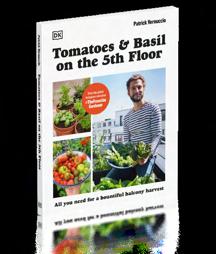
Tomatoes and Basil on the 5th Floor
Patrick Vernuccio is a small-space grower with a big message. Building on his inspirational social media content, the book showcases easy and informative ways to grow fresh produce in containers and on a balcony, proving that anyone can enjoy tasty, organic food all year round – no matter how limited your space. £14.99
Your questions answered by our resident gardening expert
Q I’m getting a bit frustrated because the weeds in my drive seem to be getting bigger and bigger. I have tried pulling them up from the cracks in my paving but they just come back larger and stronger. What’s going on and what can I do? John, Glasgow

AI feel your pain! Pulling the weeds makes them feel under threat, so their natural reaction is to hunker down, strengthen their root system and come back stronger. There's two choices: get on your hands and knees and dig out the roots by hand. If that’s not possible, use Resolva Pro Weedkiller as it kills the roots, giving you long lasting results.
from cutting the blooms and enjoying them inside – anything I can do?

Q I have lavender hedging along the edge of my lawn which overhangs and causes the lawn underneath to die and turn to moss. When I cut the lavender back at the end of the season, I’m left with unsightly patches along the edges of my lawn. What can I do? Megan, Cardiff
Martin, Galway
A This sounds like you have whitefly on your plants. Insect populations rise and fall from season to season, year to year, so it’s nothing to worry about.
Firstly, ensure you have lots of wildlifeattracting plants near the roses – whitefly are food for other visitors, so ensure you’re welcoming a range of wildlife.
Secondly, try using your hosepipe to spray them off. Finally, there is a bee, wildlife, pet and child-friendly product called Westland Rose Guard which can be used once a week. Spray it on the top and underside of the leaves to help prevent bug infestations, and it will also instantly feed them, giving you healthier plants too.

Q My mum and dad have told me I need to know what sort of soil I have in my garden. How do I go about finding out?
Jacob, Stratford

A There's a few things you can do and certainly keep pruning your lavender every year after it has flowered – late August through early September. Pruning ensures the plants thrive for many years and provide lots of lovely flowers. You could widen the border that the lavender sits in to give it more space – and then underplant it (with things like winter pansies) each autumn. To help your lawn recover and to deal with the moss I would use Aftercut Moss Killer in the autumn. This will kill the moss and it will feed the roots of the lawn, ensuring a better start the following spring.
Q I love my roses but they always seem to get lots of little bugs on them just when they are looking their best. It stops me
A Knowing your soil is useful as different plants thrive in different conditions so, as ever, mum and dad are right! You can learn quite a lot by looking at soil… sandy and stony will be quick to dry out so you may need to water plants more often, but on the flip side, plants will develop good roots as they search for moisture. Solid, sticky soil will probably mean it is a type of clay. This will be the opposite of sandy soil and be more likely to flood and stay wet throughout the year – although in a hot summer it might dry and cracks will appear. Pop down to your local garden centre: they’ll show you a selection of soil test kits.
Have you got a question for Dr. Westland? If so, get in touch and we’ll answer your questions in the next issue. doctor@westland.com

We’re all feeling the pinch right now, so we’ve handpicked some garden essentials that’ll help you look after the pennies this spring

Every gardener needs a collection of trusted tools to keep their garden in tip-top shape. From digging spades and forks, to hedge shears and hand trowels, tools really do have to withstand a lot every year. Making sure your tools stand the test of time is why Kent & Stowe only uses premium materials like stainless steel and ash wood, and the brand's stainless steel tools come with a 15-year guarantee too.
Visit kentandstowe.com for more information.


There’s simply nothing better than looking out your window to see a freshly mowed, lusciously green lawn. Keeping on top of your spring and autumn lawn care is the secret to healthy grass and with Westland’s Gro-Sure 30m2 box of Multi-Purpose Lawn Seed you can enjoy 20% extra free, so there’s an extra 6m2 of lawn you can seed for free! This quality blend is perfect for overseeding or even starting a new lawn.
Visit gardenhealth.com/grosure-lawn for more information.


This season birds will be busy feeding their young, so keeping your bird feeder topped up helps to keep wildlife happy. If you want to attract an array of colourful birds to your garden, then the Peckish Complete Seed Mix is a perfect choice, and you get 20% extra free with 1.7kg and 12.75kg bags. The mix is packaged in 100% recyclable paper packaging too.
Visit peckishbirdfood.com for more information.


Who doesn’t love a juicy, home-grown tomato? If you’re planning on growing tomatoes this year it is worth stocking up on Westland’s Big Tom Super Tomato Food, which can be bought in a 1 litre bottle with 25% extra free. Tomato plants always do better when you feed them, and Big Tom guarantees 3x more* fruits thanks to its nutrient-rich formulation of iron, magnesium and seaweed. *By weight vs unfed tomato plants
Visit gardenhealth.com/bigtom for more information.





With every bag sold, the New Horizon Fund grows. New Horizon All Plant compost is naturally peat free and delivers healthier, stronger, and more vibrant plants, and now our compost is supporting community gardening projects across the UK and Ireland, from schools to care homes.
To nominate a charity or cause, scan the above QR code or visit www.gardenhealth.com/new-horizon-fund
EVERY BAG HELPS TO GROW A GREENER FUTURE!